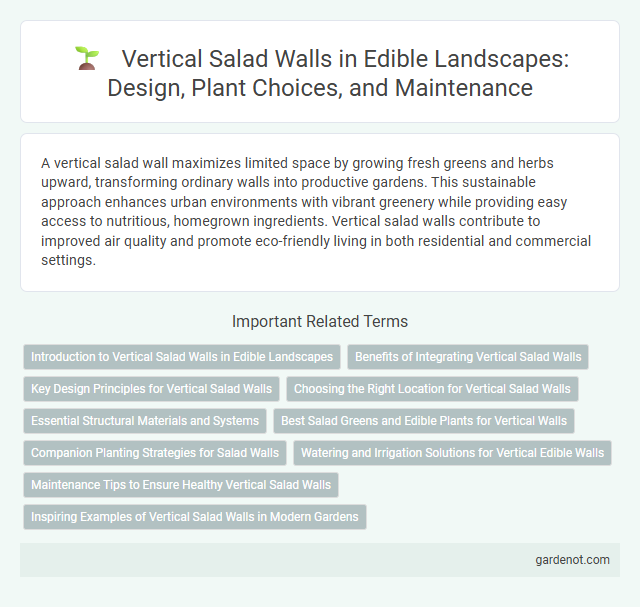A vertical salad wall maximizes limited space by growing fresh greens and herbs upward, transforming ordinary walls into productive gardens. This sustainable approach enhances urban environments with vibrant greenery while providing easy access to nutritious, homegrown ingredients. Vertical salad walls contribute to improved air quality and promote eco-friendly living in both residential and commercial settings.
Introduction to Vertical Salad Walls in Edible Landscapes
Vertical salad walls transform limited urban spaces into productive edible landscapes by growing leafy greens and herbs vertically. These structures use modular panels or hydroponic systems to optimize sunlight and water efficiency, enhancing yield in compact environments. Incorporating vertical salad walls supports sustainable gardening practices and provides fresh, easily accessible produce year-round.
Benefits of Integrating Vertical Salad Walls
Vertical salad walls maximize limited urban space by transforming bare walls into productive, green surfaces that yield fresh, nutrient-rich greens. Integrating these living installations improves air quality, reduces urban heat, and enhances aesthetic appeal while promoting sustainable food production. The systems encourage local harvesting, reduce food miles, and foster biodiversity in densely populated environments.
Key Design Principles for Vertical Salad Walls
Vertical salad walls optimize space by integrating modular planting systems with efficient irrigation that ensures consistent water distribution. Selecting lightweight, nutrient-rich growing media supports root health while maintaining structural integrity for wall mounting. Incorporating diverse plant species based on sunlight exposure and microclimate conditions enhances biodiversity and maximizes vertical garden productivity.
Choosing the Right Location for Vertical Salad Walls
Selecting the ideal location for a vertical salad wall involves prioritizing areas with ample natural sunlight, ideally 4-6 hours daily, to ensure healthy plant growth and vibrant foliage. Proximity to kitchens or dining spaces enhances convenience for harvesting fresh greens and herbs, while easy access to water sources simplifies regular irrigation. Attention to wall orientation and protection from strong winds or extreme temperatures will optimize plant health and longevity in edible landscaping.
Essential Structural Materials and Systems
Vertical salad walls rely on essential structural materials such as galvanized steel frames, rot-proof PVC panels, and lightweight aluminum supports to ensure durability and stability. These systems integrate modular planting pockets made from breathable felt or geotextile fabrics to promote healthy root aeration and efficient water drainage. Advanced irrigation technologies, including drip or hydroponic systems, are embedded within the structure to optimize nutrient delivery and maintain consistent moisture levels for leafy greens and herbs.
Best Salad Greens and Edible Plants for Vertical Walls
Vertical salad walls thrive with nutrient-rich, fast-growing greens like spinach, arugula, and butterhead lettuce, which adapt well to limited soil and vertical conditions. Complementing these, edible herbs such as basil, cilantro, and mint enhance flavor profiles while maximizing space efficiency on vertical structures. Incorporating flowering edible plants like nasturtiums and pansies not only adds vibrant color but also attracts pollinators, improving overall plant health and yield.
Companion Planting Strategies for Salad Walls
Vertical salad walls benefit from companion planting strategies that maximize space and enhance plant health by pairing compatible species such as lettuce with herbs like basil or chives, which deter pests and improve flavor. Incorporating nitrogen-fixing plants like beans alongside leafy greens enriches soil fertility, promoting robust growth without synthetic fertilizers. Strategic layering of fast-growing and slow-growing salad plants optimizes sunlight and airflow within the vertical structure, ensuring higher yields and reduced disease risk.
Watering and Irrigation Solutions for Vertical Edible Walls
Vertical salad walls thrive with efficient watering and irrigation solutions designed to conserve water while ensuring uniform moisture distribution. Drip irrigation systems equipped with timers and moisture sensors optimize water use, preventing overwatering and root rot in vertical edible landscapes. Integrating rainwater harvesting or greywater recycling further enhances sustainability for these innovative green walls.
Maintenance Tips to Ensure Healthy Vertical Salad Walls
Regular watering using drip irrigation systems prevents over- or under-watering, crucial for maintaining healthy leafy greens on vertical salad walls. Periodic pruning and harvesting of mature leaves promote continuous growth and prevent overcrowding. Monitoring for pests and diseases with organic treatments ensures a thriving, sustainable vertical edible landscape.
Inspiring Examples of Vertical Salad Walls in Modern Gardens
Vertical salad walls transform limited garden spaces into lush, edible green sanctuaries by integrating a variety of leafy greens and herbs in stacked planters. Inspiring examples include urban rooftop gardens in cities like New York and Tokyo where vertical salad walls maximize space and provide fresh produce year-round. These innovative installations enhance aesthetics while promoting sustainable food production and improving air quality in modern green landscapes.
Vertical salad wall Infographic

 gardenot.com
gardenot.com